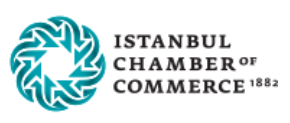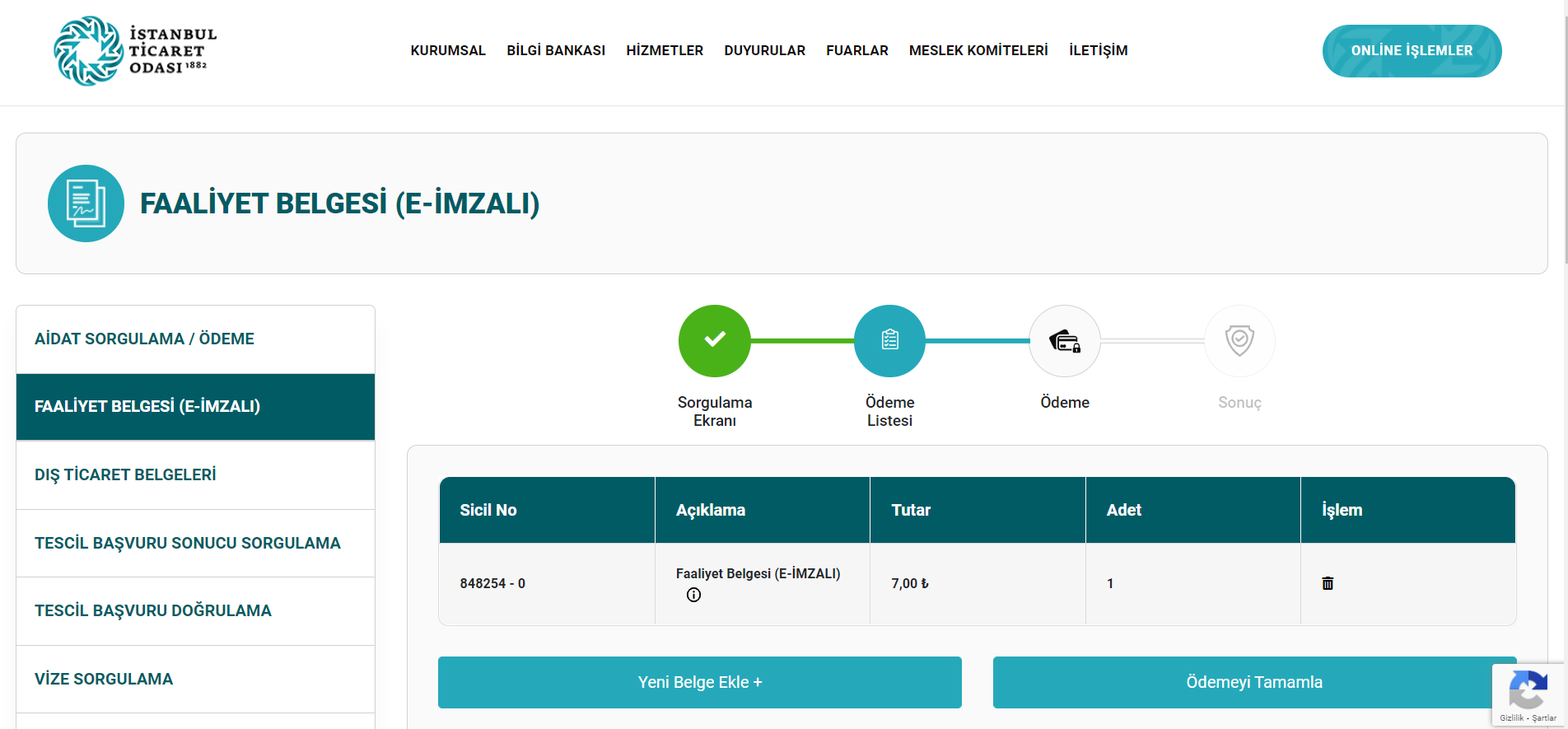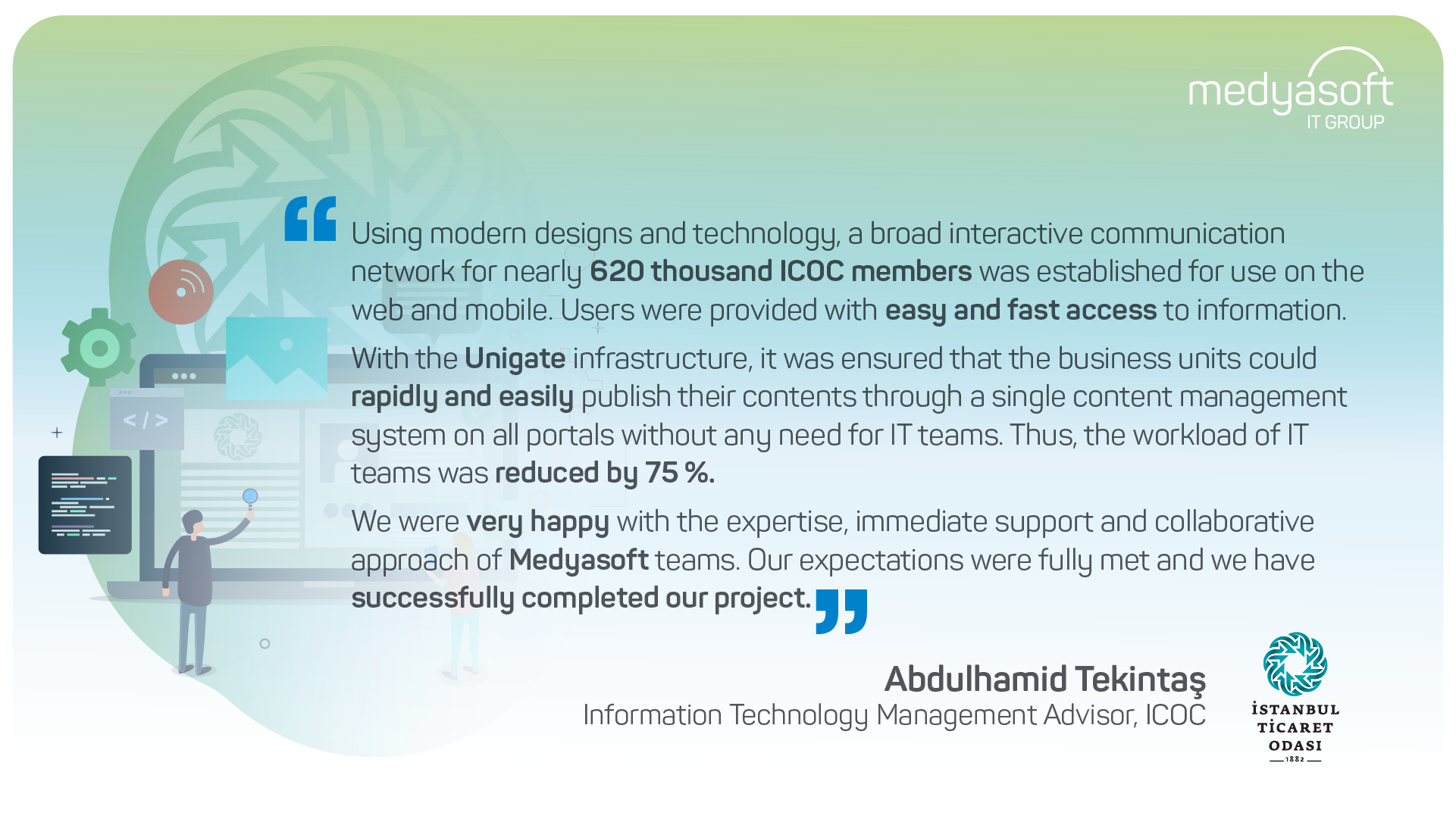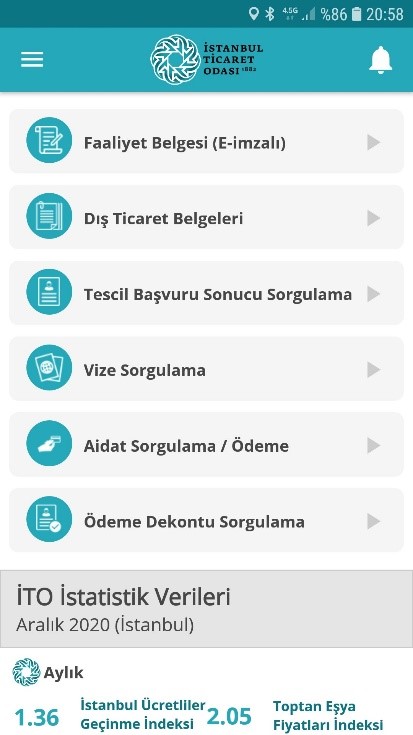The Website and Business Portals of Istanbul Chamber of Commerce Have Been Renewed with the Infrastructure of Unigate
.png)

Name of Institution: Istanbul Chamber of Commerce
Sector: Non-Governmental Organization for Public Interest
Headquarters: Istanbul, Turkey
OVERVIEW
Istanbul Chamber of Commerce (ICOC) is currently among the longest-established and largest chambers of commerce across the world with almost 620 thousand members. Offering various services on various platforms, Istanbul Chamber of Commerce aims to enable a more powerful and interactive access to all its members. As part of the Digital Transformation Project carried out to this end, joint efforts towards Content Management Systems were made by ICOC and Medyasoft.
At the end of the project that was implemented with the aim of providing the contents of the institution faster, more securely and with 24/7 access to the members of ICOC, ICOC Corporate Internet Site, ICOC Data Bank, ICOC Online Services and ICOC Council Members Management Portal were deployed on the web systems of Istanbul Chamber of Commerce; as well as ICOC Corporate Website and ICOC Online Services in the iOS and Android mobile systems with the Unigate infrastructure.
As the production of content services offered throughout the institution have radically changed with this extensive project, employees working outside of the Information Technology (IT) department and not possessing extensive knowledge in IT could also be involved in the process and were able to easily manage content services with UNIGATE.
SOLUTION FEATURES
- Middleware structure: The application was set up with the middleware configuration tailored to the project where multiple systems work in an integrated structure and a new system can be rapidly integrated. Thus, performance problems have been reduced and service security has been increased.
- Error detection: As the detection of user errors and effects in the systems used by multiple users increase the reliability, availability and continuity of the project, error detection through log files was enabled and quick and proper solutions were provided to the problems detected.
- Ease of maintenance and flexibility: The layered architecture structure where each layer is independent of the others enabled the updates or changes to be realized without affecting the application as a whole. Moreover, the ability to manage and scale each layer independently increased flexibility.
- Meeting the need for electronic documents 24/7: Medyasoft has created its own document signing application as part of this project, instead of the high-cost applications used in the sector. This software has been developed using the e-signature libraries of the TurkTrust company. As a result, the signing system that makes even distribution with Loadbalancer and works with 4 tokens was put into use.
- Flexible payment configuration: A configuration that can easily be integrated to all banks has been established.
REQUIREMENTS AND CHALLENGES
As a result of the advance in technology, changing business models and needs, strategies toward developing new portals in institutions are becoming an inevitable requirement. Based on this requirement, ICOC also felt the need to renew of their portal utilizing the new intranet and web technologies and modernize their infrastructure and systems. The reasons behind this need can be listed as follows:
- Not being able to provide broad and interactive communication for nearly 620 thousand ICOC members
- Design and technology being insufficient in meeting the usage needs in mobile devices
- The inability to position the content and services produced within the institution under the correct title on the website, end users having difficulties in accessing content and information due to insufficiencies in user interface and user experience
- Insufficiency of online payment infrastructure for membership fees
- Inability to meet the intensive demand for e-signed operating certificate
- The data of 261 council members, 341 professional committee members and 61 public enterprise members being managed on separate databases
- Out of the 600 ICOC employees, two thirds submitting a request to senior management about changing both the technology and the interface of the corporate website
- The workload and waste of time caused by organizing the agenda documents of the monthly council meetings attended by 261 council members via postal service
In addition to these, there was a need for the management of different processes more rapidly and efficiently. For example, ICOC business units could make requests to the IT teams for corporate site content every day of the week, in unspecified hours or in some cases the content could be requested to appear on the site urgently. These kinds of content requests created a serious workload for IT employees. Similarly, new page development requests could also interrupt the workflows of IT employees and make their planning processes more difficult. Not having enough technical experts to meet these kinds of requests and make the necessary developments required by the new technologies meant even more time pressure and workload for the IT teams.
THE APPROACH
In such projects, it is important to determine the correct technology first and then create the suitable infrastructure, in order to identify the needs and challenges and provide solutions for them. Used in over 100 enterprises in Turkey and other countries, UNIGATE offers a solution to meet this need in infrastructure and technology.
The project implemented by Medyasoft aimed to enable fast and easy access to information by creating strategies for the appropriate user interface and user experience. For this purpose, the existing situation and requirements were analyzed. Specifically, for online services and the feedback of end users who use them, the requirements for the Online Services portal were determined. Analyses were made according to these requirements and these studies were enhanced by user interface and user experience strategies. The project enabled simple and functional features for the corporate website of ICOC.

THE CONTEXT OF THE COLLABORATION
Established in 1882, Istanbul Chamber of Commerce operates as one of the few chambers of commerce in Turkey and the world. It is quite important for such a large enterprise to reply to end user expectations with effortless digital experiences.
On the other hand, the old systems and working methods of the corporation could be a major obstacle against the digital transformation. Istanbul Chamber of Commerce aimed to create an architecture that would enable producers to meet the requests received from the business units, instead of meeting these requests centrally within IT. Within this scope, the Istanbul Chamber of Commerce determined 4 strategic digital business goals for the digital transformation efforts:
- A technological infrastructure that is in use in all digital platforms and adaptable to future technologies
- Web portals with a powerful user experience and user interface, a correct content hierarchy setup, fast and easy access to content
- A setup that enables interactive communication with website visitors and nearly 620 thousand members
- Management of all portals through a centralized CMS (Content Management System) and management of all users over the same CMS with single sign on (SSO) structure from a single point
SOLUTION DETAILS
Detailed information on the solution architecture applied in the project is explained under the subheadings below.
.png)
Solution Architecture
Presentation and Service Layer
Five different configurations were set up as online services, corporate portal, council portal, admin panel for requests and mobile application. In this configuration set up by creating the SSO configuration, creating the middleware configuration provided the shared services. With the middleware configuration the shared services were configured in a way to be managed from a single point and used in multiple applications. Additionally, an application with a configuration that can be integrated with external services was developed.
The portal application was developed in a client and SPA architecture; while the mobile application was developed as two separate native applications and enabled to work in integration with the middleware configuration created in the N-Tier architecture.
Middle layer software that provides services to many applications such as the portal and the corporate application was developed through the Db2 integration. In the portal and the admin panel SSO Middleware structure was set up for login operations and login operations on all ICOC infrastructure were provided over SSO. This way, all user data could be stored on a single point when logging in to the system.
Integrations:
Payment channels were expanded by way of integration to different bank payment systems. Within this scope Garanti Bankası, Ziraat Bankası, Halkbank, Akbank, Kuveyt Türk Katılım Bankası, Vakıfbank and Türkiye İş Bankası virtual POS integrations were performed.
Business layer:

As shown in the image below, on the Online Services portal, membership fee inquiry and payment, operating certificate, trade registry gazette, foreign commerce documents, registration application status inquiry, registration application verification, visa inquiry, payment receipt inquiry transactions can be made.
An admin panel has been set up to meet the requests for operating certificates, trade registry gazettes and foreign commerce documents. On the admin panel, there is an authorization mechanism managed via Unigate Content Management for the authorization regarding the modules. Users registered in Unigate can access the admin panel in the system through member login. Users on the admin portal are authorized based on their roles and can view the modules covered by their authorization to respond to requests for signing and printing documents, writing receipts, and sending e-mails. There are such modules as Operating Certificate (e-signed requests, or those signed in wet-ink), Foreign Trade Documents, and Payments in the application. These enable users to fulfill document requests and check payment status.
Thanks to SSO a shared login infrastructure was created for all applications used in the mobile application, admin portal and all applications used on ICOC side.
In payment transactions a Java API was developed to invoke Db2/RPG programs. Thanks to this API, document control, debt inquiry and collection transactions can be realized through a single program.
For creating e-signed documents, a desktop application was developed using the e-signature libraries of TurkTrust company. The document was placed in line after the payments and then signed using this application. Thus, e-signed document requests could be met 24/7. The system also allows manual signatures for any possible problems that may occur in the line. Services for the transfer of documents and receipts were created on the server that works as Windows services. With the RabbitMQ technology, multiple data were put into a queue and processed in order.
In order to control the payment status on the banking side, integrations were made on each bank’s transaction inquiry services.
Integration was made to services developed on the ICOC side for modules that would enable transactions such as registration inquiry transactions.
Data Layer:
On the online services application, in order to enable to store the documents with e-signatures for 60 days as well as the structures working in integration with external services, schedule job was created on the database. The MSSQL database enabled the storage of received documents.
For the network or service problems that occur in payments, transaction configuration has been implemented. Payment information was kept on MongoDB application before the payments were performed, and the transaction control was made after that. Moreover, to minimize manually performed transactions, services that check the status of all payments and work as Windows services created by using each bank’s transaction inquiry APIs.
Through connection to the Db2 service, service integration was ensured to extract data.
Cross Cutting:
Caching:
In order for the large amount of data retrieved from the database not to cause performance issues, cache was implemented by using the Redis configuration in the middleware configuration.
Logging:
In order for the application log files to be examined and to easily detect error logs, log files were printed with the Graylog software and displayed on the Graylog interface. For the detection of most frequently used services and daily service errors, Graylog’s dashboard feature was used.
Exception Handling: An exception handling mechanism was set up to identify possible errors such as authorization errors, errors received upon payments, database connection problems and the actions to be taken to handle them.
Validations:
Client side and server side validations were written on each module to prevent the roaming of invalid data that on the system, and avoid exceptions. Reduction in error rate was achieved through custom validations.
System Security:
All requests are met with a firewall in the system. Thus, security gaps like CSRF, XSS, DDOS are prevented.
After logging in to the system to access the modules in the admin panel, the system requires user token information. With services not responding unless token information is received, service security is ensured.
The application received nearly 1 million requests per day. For the application to respond to these requests rapidly, the UI (user interface) and middleware layers work behind Load-balancer.

RESULTS
As a result of meeting all the requirements explained under the title “Requirements and Challenges” by the UNIGATE solution and the new technological infrastructure support offered to Istanbul Chamber of Commerce by Medyasoft; ICOC obtained the following benefits:
1. Editor groups in ICOC business units can easily use content Management System without the need for technical knowledge. Editors can carry out their daily operational practices without the support of IT thanks to the training programs and user manuals for UNIGATE.
2. As the Middleware configuration allows the application to work in integration with multiple systems, different ICOC applications could be integrated into the system. As the applications, updates or changes were carried out in a layered architecture and without affecting the application as a whole, the system also provides ease of maintenance. Thus, the workforce losses of the ICOC IT department has been reduced by 75 percent with significant time savings.
3. On the online services platform where 1,500 operating certificates are requested and nearly 500 companies make payments on a daily basis, errors are identified in a short time, providing fast and correct solutions thanks to logging. In addition, the ability to identify the effects of system errors improves the reliability, availability and continuity of the project.
4. The implementation of the most up-to-date technology in the Content Management System (CMS) enabled easily adaptation of all change requests to CMS and thus, a sustainable maintenance support process, while contributing to reduce costs to 50 percent. Ensuring the same quality of end user experience regardless of the device or browser used to visit the website had a positive influence on customer satisfaction.
Through this project carried out in collaboration by Medyasoft and ICOC, the requirements of both the business units managing the web portals and the IT unit were met, while brand awareness was enhanced by providing a better service to the end user.
As a result, a contribution was made in terms of membership loyalty and a healthy communication in all portals of the institution, thanks to a powerful approach focused on members and end users and a sustainable infrastructure.
SUGGESTIONS/RECOMMENDATIONS
As part of the ICOC Digital Transformation project, an easily accessible corporate portal equipped with current technologies, which meets the expectations of members and employees and provides uninterrupted service was created in line with the corporate identity of Istanbul Chamber of Commerce.
Within the corporate portal, numerous integrations have been made with AS/400 and other systems. Online inquiry of all member data and display of member data was enabled. As a result of these efforts, the page was put into service with the outlook below.

A middleware layer was created for double-sided integration with AS/400 and other systems, and an expandable configuration was made with the flexible micro-service architecture.
With the responsive design created, nearly 72 percent increase was obtained in use on mobile devices. As demonstrated by the image below, providing a user-friendly design and visual functionality increased the visitor number of the portal by 32 percent.

As the access of users to information they seek has been easier thanks to the new information architecture, the average time users spend on the portal has been reduced. Thanks to the Content Management System being adapted to the structure and needs of ICOC, content owners were provided with flexible data entry based on authorization.
Providing online access to information requested by official correspondence within the framework of exclusive protocols made between ICOC and certain public institutions also means savings in time, costs and workforce.

 Tr
Tr